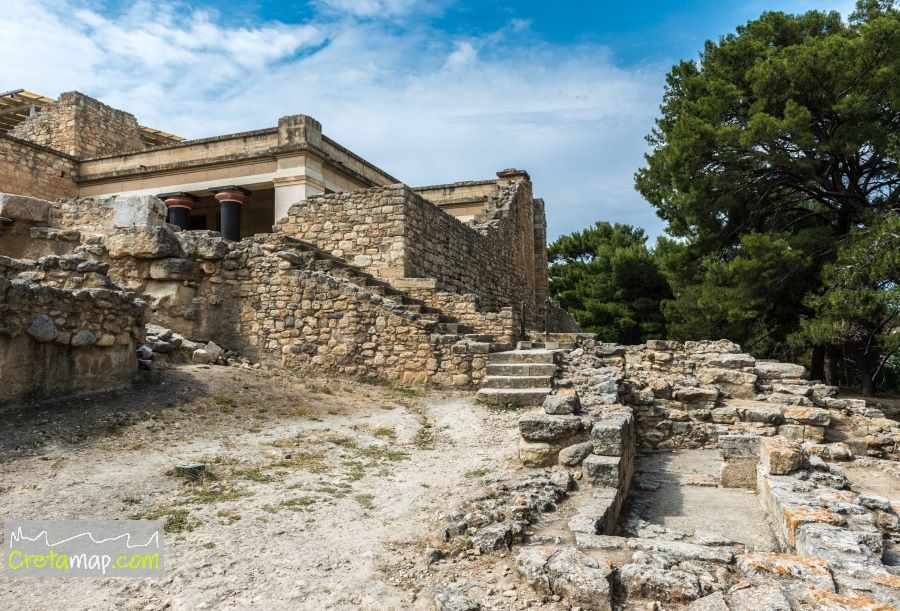Knossos is the site of the most important and better known palace of Minoan civilization.
It was the seat of the legendary king Minos.
The site was continuously inhabited from the Neolithic period (7000-3000 B.C.) and was abandoned after its destruction in 1375 BC which marked the end of Minoan civilization.
The first palace on the low hill beside the Krairatos river was built around 1900 BC on the ruins of previous settlements.
It was destroyed for the first time along with the other Protopalatial palaces around Crete at 1700 BC, probably by a large earthquake or foreign invaders.
It was immediately rebuilt to an even more elaborate complex and until its abandonment was damaged several times during earthquakes, invasions, and in 1450 BC by the colossal volcanic eruption of Thera, and the invasion of Mycenaeans who used it as their capital as they ruled the island of Crete until 1375 BC.
The Palace is also connected with the myth of the Labyrinth and the Minotaur, and the story of Daidalos and Icaros.
The palace of Knossos was the center of administration of the entire island during Minoan times, and its position as such allowed for unprecedented growth and prosperity as witnessed by the plethora of storage magazines, workshops, and wall paintings.
The Throne room with its gypsum throne and benches to accommodate sixteen persons, the central courtyard, and the theater, along with the royal chambers paint a portrait of Knossos as a forum of elaborate rituals and extraordinary historical occurrences.
The Linear B tablets (Mycenaean script) of the 14th century B.C. mention the city as ko-no-so.
Intensive habitation occurred mostly in the Minoan period, when the so-called first (19th-17th centuries B.C.) and second palaces (16th-14th centuries B.C.) were built along with luxurious houses, a hospice and various other structures.
After its partial destruction in 1450 B.C., Knossos was settled by Mycenaeans from the Greek Mainland.
The city flourished again during the Hellenistic period (sanctuaries of Glaukos, Demeter, other sanctuaries, chamber tombs, north cemetery, defensive towers) and in 67 B.C., it was captured by the Roman Quintus Caecilius Metelus Creticus.
The “Villa of Dionysos”, a private house with splendid mosaics was built in the same period.
Knossos was discovered in 1878 by Minos Kalokairinos.
Arthur Evans conducted systematic excavations at the site between 1900 and 1931, bringing to light the palace, a large section of the Minoan city, and the cemeteries.
Since then, the site and the surrounding area have been excavated by the British School of Archaeology at Athens and the 23rd E.P.C.A.
The restoration of the palace to its present form was carried out by Arthur Evans.
The interventions were mostly imposed by the need to preserve the monuments uncovered.
The Archaeological Service of the Ministry of Culture carries out only consolidation work, whenever necessary.
The most important monuments of the archaeological site are the following:
The Palace of Knossos, (2000-1350 B.C.) is the largest of the preserved Minoan palatial centres.
Four wings which contain the royal quarters, workshops, shrines, storerooms, repositories, the throne room and banquet halls are are arranged around a central courtyard.
The Little Palace (17th-15th centuries B.C.) lies to the west of the main palace and has all the features of palatial architecture: scraped wall masonry, reception rooms, a pristyle hall, a double megaron with polythyra (pi er-and-door partitions) and a lustral basin-shrine.
The Royal Villa, dated to the 14th century B.C. lies to the NE of the palace and its architectural form is distinguished by the polythyra, the pillar crypt and the double staircase, with two flights of stairs.
It is strongly religious in character and might have been the residence of an aristocrat or a high priest.
House of the Frescoes (15th, 14th-12th centuries B.C.) is located to the NW of the palace and is a small urban mansion with rich decoration on the walls.
The Caravanserai lies to the south of the palace and was interpreted as a reception hall and hospice.
Some of the rooms are equipped with baths and decorated with wall paintings.
The Unexplored Mansion is a private building, probably of private-industrial function, to the NW of the palace.
It is rectangular, with a central, four-pillared hall, corridors, storerooms and remains of a staircase.
It is dated to the 14th-12th centuries B.C.
The Temple Tomb is located almost 600 m. to the south of the palace and was connected with the “House of the High Priest” by means of a paved street.
It seems that one of the last kings of Knossos (17th-14th centuries B.C.) was buried here.
Typical features of its architecture are the hypostyle, two-pillar crypt, the entrance with the courtyard, the portico and a small anteroom.
The House of the High Priest lies 300 m. to the south of Caravanserai and contains a stone altar with two columns, framed by the bases of double axes.
The South Mansion, a private civic house, is located to the south of the palace.
It is a three-storeyed building with a lustral basin and a hypostyle crypt, dating from the 17th-15th centuries B.C.
The Villa of Dionysos is a private, peristyle house of the Roman period, dated to the 2nd century A.D.
It is decorated with splendid mosaics by Apollinarius, depicting Dionysos.
The house contains special rooms employed for the Dionysiac cult.
The Palace of Knossos is located about twenty minutes south of Heraklion.
It can be accessed via bus No 2 “Knossos”.
Source: odysseus culture
Note:
Opening hours: 1 Jun - 31 Oct : Mon-Sun, 8:00-20:00 1 Nov - 31 May Mon-Sun: 8:30-15:00













